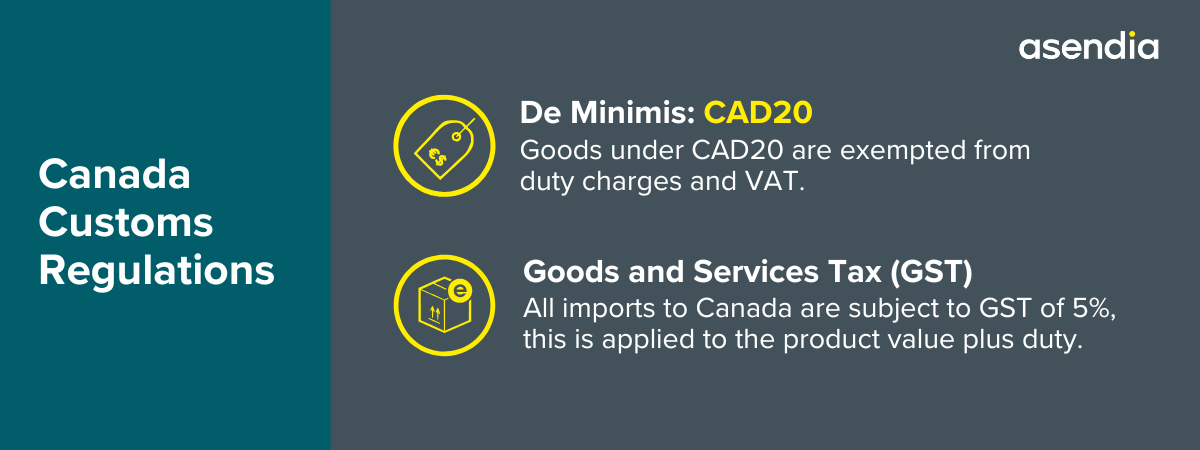Customs Regulations Overview in Canada

In Canada, the De Minimis Value is set at CAD 20, which means you won’t have to pay taxes and duties on shipments valued below this amount. However, if your shipment exceeds this threshold, you will be responsible for any applicable duties and taxes. Additional taxes, such as excise duties or luxury taxes, may also apply depending on the nature or value of the goods. For gifts received from family or friends abroad, the GST is exempt for items valued at CAD 60 or less.
Source: Canada Border Services Agency | ITA
Import Tax
When importing goods into Canada, you are required to pay the Goods and Services Tax (GST) or the federal portion of the Harmonized Sales Tax (HST), except for items designated as non-taxable imports. Both GST or HST are collected at the time of import, along with any applicable duties and taxes.
The GST in Canada is a 5% federal tax applied to the value of the product plus any duties. Several types of provincial taxes exist:
- Provincial Sales Tax (PST) is an additional tax that some provinces impose on top of the GST.
- Harmonized Sales Tax (HST) combines PST and GST into a single, simplified rate in certain provinces.
- Quebec Sales Tax (QST) is a distinct provincial tax specific to Quebec.
The rate of PST or HST varies depending on the destination province. For more information on import requirements, duties, and taxes, you can visit the Canada Border Services Agency's website for further details.
Required Customs Documents
Prior to importing commercial goods into Canada, you must obtain a Business Number (BN) from the Canada Revenue Agency (CRA). This process is typically free and can be completed fairly quickly. You can register for a BN for your import account by visiting the CRA’s website.
Additionally, there are several customs documents that you need to prepare before importing goods into Canada:
1. Airway Bill or Bill of Lading
If your import is done via air freight, an airway bill is required. For shipments via sea freight, a Bill of Lading (BLAD) is needed. Both serve the same purpose: to provide detailed information about the shipment and enable tracking.
2. Canada Customs Invoice or Commercial Invoice
The commercial invoice is typically used to establish the actual value of goods for customs duty assessment. In contrast, a Canada Customs Invoice (CCI) is a specialized document that includes more detailed information than a standard commercial invoice.
If you are exporting to Canada and the value of your commercial shipment is CAD 2,500 or higher, a CCI is required. Additionally, the items in the shipment will be subject to sales tax and other duties. However, there are exceptions; for instance, items classified under HTSUS Chapter 9810 do not require a Canada Customs Invoice.
The CCI typically includes the following:
- Items’ country of origin
- Transportation mode
- Currency of settlement
- Date of direct shipment to Canada
- Total weight
To view an example of the CCI or for more information, please visit the Canada Border Services Agency’s website.
3. Canada Customs Coding Form (B3-3)
The B3-3 form is an accounting document used to pay duties and taxes. When filled out accurately, it provides all the information required for the CBSA to facilitate the release of the shipment. This document generally includes the following details:
- Importer name and address
- Port of unloading
- Country of origin
- Direct shipment date
- Description
For more information on the Canada Customs Coding Form (B3-3), please visit the Canada Border Services Agency’s website.
4. Certificate of Origin
The CBP Form 343 – North American Free Trade Agreement (NAFTA) Certificate of Origin is used to identify the country of manufacture or origin for the goods. If your shipment is valued at over CAD 3,000, you will need a NAFTA Certificate of Origin.
5. Electronics Export Information (EEI)
To ship goods across the border into Canada, you must complete the Electronics Export Information form. This form is used by the US Census Bureau to monitor trade statistics and guide trade regulations.




a.jpg?width=1375&height=1247&name=pexels-mizunokozuki-13443801%20(1)a.jpg)
.jpg?width=2000&name=pexels-karolina-grabowska-5237646%20(1).jpg)
n.jpg?width=2000&name=pexels-ivan-samkov-7620627%20(1)n.jpg)








